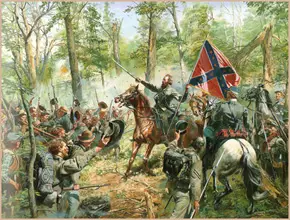Link To This Page — Contact Us —
The Battle of Cedar Mountain
August 9, 1862 in Cedar Mountain, Virginia



| |||||||||||||||||||||
|
A new threat to the Confederacy lurked in Northern Virginia in the summer of 1862. Two previous threat had already been successfully opposed by the Southerners. Confederate forces under Maj. Gen. Thomas J. "Stonewall" Jackson had thwarted Union designs in the Shenandoah Valley earlier in the year. The emergence of Gen. Robert E. Lee insured the safety of Richmond by driving Union troops away from the Confederate capital in the Seven Days battles. A desperate Lincoln Administration next turned to the bombastic Maj. Gen. John Pope. Pope forged an army out of the several Union commands embarrassed by Jackson in the Valley and christened his new fighting force the Army of Virginia.
Vexed by Pope's move on Culpeper Court House and that officer's alarming proclamations against Southern civilians, Lee quickly dispatched Jackson to Gordonsville with the grave order: "I want Pope to be suppressed."
Outnumbered by Pope's forces, Jackson looked for an opportunity to strike. Pope unwittingly divided his army along the Rapidan River. Jackson then advanced hoping to isolate a portion of Pope's army near Culpeper. Although he had been reinforced by Maj. Gen. A.P. Hill's large "Light Division," Jackson plans almost immediately went awry, and he could make little headway. Hampered by poor roads and problematic orders, Jackson vented his frustrations on Hill, sparking the most celebrated feud in the history of Lee's lieutenants.
Pressing forward on August 9, Jackson's troops tramped on the main road to Culpeper in brutally hot weather. The exhausted Confederates encountered Union cavalry blocking the road near Cedar Run. Brig. Gen. Jubal A. Early hastily formed a line of infantry and artillery perpendicular to the road with the right of the Confederate line anchored on the shoulder of Cedar (or Slaughter's) Mountain. Confederate artillery firing from the mountain as well as from a small wooded knoll known afterward as the Cedars, and from a gate where the Crittenden House lane met the main road, dueled with Union artillery posted on the Mitchell Station Road. One Confederate thought the gunnery was "the prettiest artillery duel ever witnessed during the war." During the spectacular but inconclusive shelling both Jackson and division commander Brig. Gen. Charles S. Winder tried their hand as gunners. Confederates soon carried Winder off the battlefield mortally wounded when a Union shell tore away his side.
The battle entered its most furious phase shortly after 5:00 P.M. when the Union commander on the field, Maj. Gen. Nathaniel P. Banks, launched 2 attacks against the Confederate line. Union infantry waded through a cornfield heading for the Confederate guns at the Cedars, while a second group of Federals advanced toward the guns planted by the Gate.
Although outnumbered by Jackson's troops, Brig. Gen. Samuel W. Crawford's Federals struck Jackson's loosely-knit line near the Gate. Crawford shattered Jackson's left after a desperate hand-to-hand combat that one veteran remembered as "unsurpassed for ferocity by any other engagement during the war." The Federals in the cornfield under Brig. Gen. Christopher C. Augur billowed out of the corn near the guns by the Cedars.
The Confederate guns at the Gate, and the Cedars retreated while much of their infantry support fled from the Union onslaught. Jackson rode into the center of the storm waving his word with the scabbard still tightly rusted to it. Defying fire from 3 sides, Jackson brandished his "sword" and a battle flag, and banked on his name to rally the troops. One witness wrote later, "the escape of Jackson from death was miraculous. He was in the thickest of the combat, at very long range." The famed leader arrested the panic and restored order. Hill's timely arrival established a stronger line and sent the Federals reeling back across the fields. A small battalion of the 1st Pennsylvania Cavalry galloped into the teeth of the Confederate counterattack to buy time for the retreating Federals. As darkness fell, Jackson embarked on a concerted attack that swept Banks from the field.
Jackson's Confederates came dangerously close to defeat at the hands of Banks' inferior but aggressive force. Cedar Mountain was the only battle in which Stonewall Jackson attempted to draw his sword and lead his troops by example. Swayed by his personal involvement, Jackson later asserted that Cedar Mountain was "the most successful of his exploits."
Jackson could claim a victory at Cedar Mountain, for he held the field. Jackson had miscalculated, nearly suffering a humiliating defeat from an opponent less than half his strength. Banks erred by neither leaving a reserve when he attacked nor requesting reinforcements from Pope. The loss of Winder diminished the value of this hard fought Confederate victory. Two days after the battle, Jackson withdrew to meet Lee, and begin the campaign leading to the battle of the 2nd Manassas/Bull Run and the demise of Pope. Once joined with Lee, Jackson never again directed a campaign as an independent commander.

